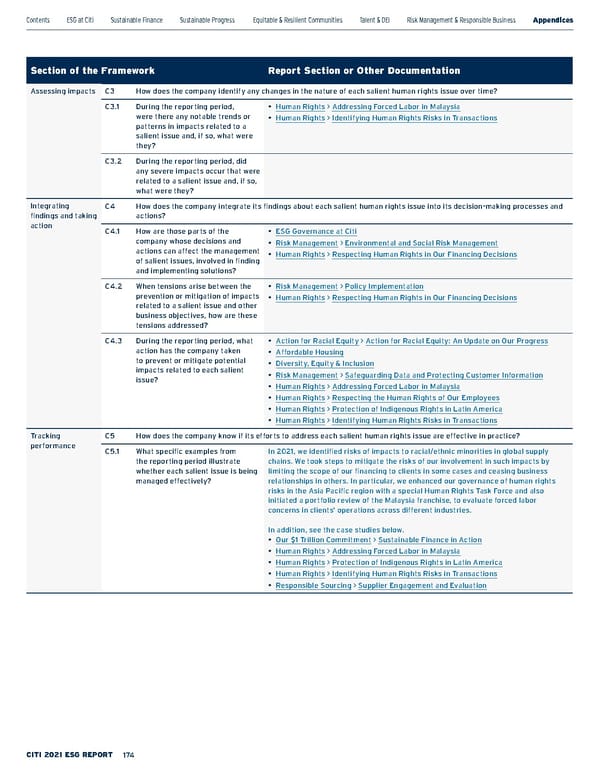Section of the Framework Report Section or Other Documentation Assessing impacts C3 How does the company identify any changes in the nature of each salient human rights issue over time? C3.1 During the reporting period, were there any notable trends or patterns in impacts related to a salient issue and, if so, what were they? • Human Rights > Addressing Forced Labor in Malaysia • Human Rights > Identifying Human Rights Risks in Transactions C3.2 During the reporting period, did any severe impacts occur that were related to a salient issue and, if so, what were they? Integrating findings and taking action C4 How does the company integrate its findings about each salient human rights issue into its decision-making processes and actions? C4.1 How are those parts of the company whose decisions and actions can affect the management of salient issues, involved in finding and implementing solutions? • ESG Governance at Citi • Risk Management > Environmental and Social Risk Management • Human Rights > Respecting Human Rights in Our Financing Decisions C4.2 When tensions arise between the prevention or mitigation of impacts related to a salient issue and other business objectives, how are these tensions addressed? • Risk Management > Policy Implementation • Human Rights > Respecting Human Rights in Our Financing Decisions C4.3 During the reporting period, what action has the company taken to prevent or mitigate potential impacts related to each salient issue? • Action for Racial Equity > Action for Racial Equity: An Update on Our Progress • Affordable Housing • Diversity, Equity & Inclusion • Risk Management > Safeguarding Data and Protecting Customer Information • Human Rights > Addressing Forced Labor in Malaysia • Human Rights > Respecting the Human Rights of Our Employees • Human Rights > Protection of Indigenous Rights in Latin America • Human Rights > Identifying Human Rights Risks in Transactions Tracking performance C5 How does the company know if its efforts to address each salient human rights issue are effective in practice? C5.1 What specific examples from the reporting period illustrate whether each salient issue is being managed effectively? In 2021, we identified risks of impacts to racial/ethnic minorities in global supply chains. We took steps to mitigate the risks of our involvement in such impacts by limiting the scope of our financing to clients in some cases and ceasing business relationships in others. In particular, we enhanced our governance of human rights risks in the Asia Pacific region with a special Human Rights Task Force and also initiated a portfolio review of the Malaysia franchise, to evaluate forced labor concerns in clients’ operations across different industries. In addition, see the case studies below. • Our $1 Trillion Commitment > Sustainable Finance in Action • Human Rights > Addressing Forced Labor in Malaysia • Human Rights > Protection of Indigenous Rights in Latin America • Human Rights > Identifying Human Rights Risks in Transactions • Responsible Sourcing > Supplier Engagement and Evaluation Contents ESGatCiti SustainableFinance SustainableProgress Equitable&ResilientCommunities Talent&DEI RiskManagement&ResponsibleBusiness Appendices ESGS ataC ius niblnG 174
 Citi ESG Report Page 173 Page 175
Citi ESG Report Page 173 Page 175